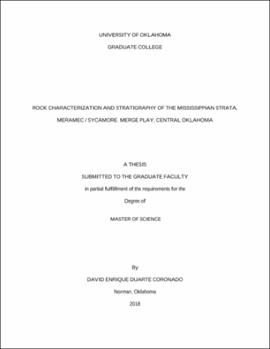| dc.description.abstract | Historically, Mississippian rocks (Meramec / Sycamore Fms.) have been a productive oil and gas formations in Oklahoma. This study followed upon two major plays that were recently identified, The Sooner Trend Anadarko Canadian Kingfisher (STACK) play and the South-Central Oklahoma Oil Province (SCOOP) play. Few studies have been published about these plays, and even less is known about the Merge play, that as the name suggests is connection between the STACK and SCOOP plays. This study identified the factors that control the stratigraphy and reservoir quality of Meramec/Sycamore and Woodford strata to build a predictive sequence stratigraphic model.
Description of two cores, thin sections, scanning electron microscopy (SEM), and X-Ray fluorescence spectroscopy (XRF) were used for the identification, analysis, and interpretation of litho- and chemofacies. Differences in geologic factors like conditions of deposition, sediment source, and burial diagenesis resulted in two major facies associations: gravity flows, and hemipelagic sediments. Gravity flows are mainly massive (unstructured) calcite-cemented siltstones and hemipelagic facies are mainly laminated and bioturbated facies.
Porosity/permeability, hardness, TOC and rock-eval data were used to evaluate the range of reservoir quality and production potential of the two rock types. There are two main types of calcite in the facies, allochems and blocky calcite cement. In the gravity flow facies, blocky calcite cement precipitated during diagenesis and consequently occludes the original porosity but in the hemipelagic facies, calcite has not been precipitated thus it does not occlude the porosity. The amount of carbonate allochems controls the hardness of the rock in the hemipelagic facies, with more allochems resulting in harder rock.
Bulk-rock carbon and oxygen isotopic composition (δ13C and δ18O) were used to interpret the origin of the blocky calcite cement and to build a relative time framework. The data suggest a marine bioclastic source of the carbonate from surrounding beds as the origin of the blocky calcite cement. Changes in the composition of the rock, in this case isotopic (δ^13 C) and elemental composition, were used to build a relative time framework and strengthen the sequence stratigraphic model. Based on this, it seems that the Mississippian/Pennsylvanian unconformity eroded the uppermost section of Mississippian strata in the Merge play.
While unconventional resources contain specific sweet spots and target zones, this integrated study demonstrates that geologic factors are still the path to quantifying and characterizing the rock potential.
An integrated study like this one depends on conditions of deposition, sediment source, and diagenesis -including distribution of the facies in the Merge play- and provided a chronostratigraphic framework, and a robust sequence stratigraphic model which provides a tool to interpret and predict genetically related depositional units in the available space. From this, sweet spots and anomalous zones could be detected. | en_US |
